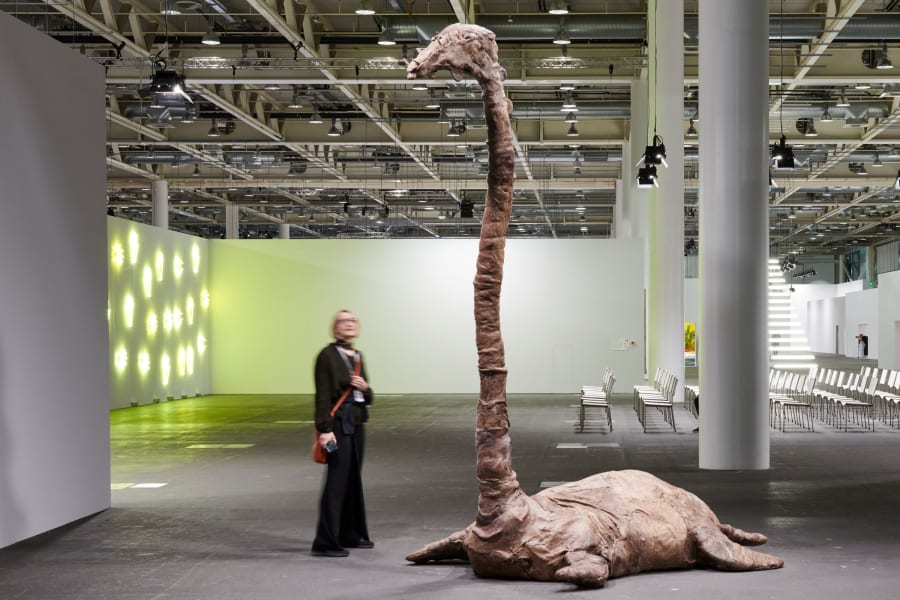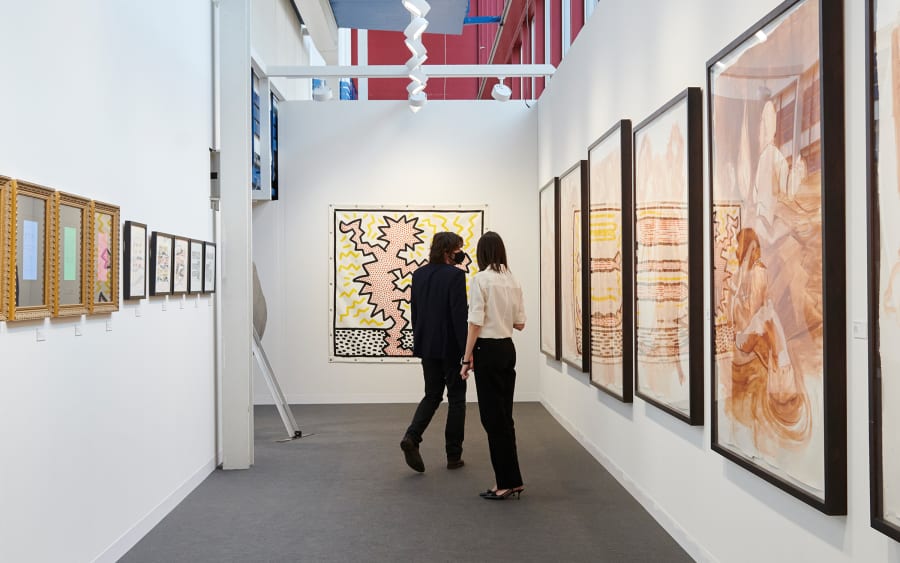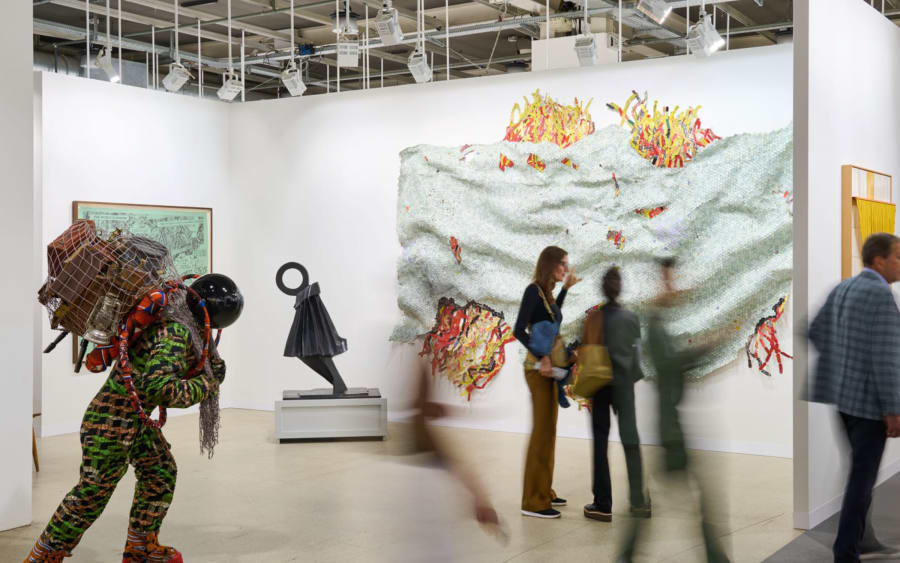In Premiere, galleries are invited to spotlight works by up to three artists, all made within the last five years. Discover the ten standout presentations of the inaugural edition.
Lin May Saeed
Jacky Strenz (Frankfurt am Main)
Before her untimely death at 50 in 2023, German-Iraqi artist Lin May Saeed spent her lifetime imagining a different world: one in which animals call the shots and humans play second fiddle. Spanning narrative reliefs, protest posters, and mythical sculptures, made with an unlikely arsenal of Styrofoam, bronze, and cardboard, her art merged ecological urgency with folkloric tenderness. In her posthumous solo presentation at Jacky Strenz’s booth, Saeed’s animals navigate their fragile dominion: a deer stands in garbage, an anteater teeters on extinction, and liberated creatures dance beneath a rainbow.
Alexandre Khondji, Kayode Ojo, and Megan Plunkett
Sweetwater (Berlin)
Shining surfaces will lure you into Sweetwater’s three-person presentation, ‘Objective’. At the center of the booth, Kayode Ojo’s The White Lotus (Hannover) (2022) glitters with faux crystals, mirrors, and fast-fashion finery, calling out the shallow shimmer of mass consumption dressed up as luxury. Nearby, Alexandre Khondji’s aluminum flood barriers redirect visitor movement with cool efficiency, reminding viewers that design is often used as a means of quiet control. On the wall, Megan Plunkett’s black-and-white prints, culled from found imagery, recall advertising’s visual grammar while draining it of its allure.
Dimitra Charamandas and Basim Magdy
Gypsum Gallery (Cairo)
Gypsum’s booth shakes things up with two artists mapping the earth’s restless moods. Swiss-Greek artist Dimitra Charamandas’s images of volcanic terrain are influenced by her travels along the Pacific Ring of Fire. In surprising contrast to their violent subject matter, the paintings are rendered in gentle, pastel-like tones. Another large-scale painting, this time on the floor, references calderas – dormant craters that act here as symbols of latent force. Alongside these works are, Egypt-born, Basel-based artist Basim Magdy’s chemically altered photographs of cruise ships, salt flats, and volcanic debris, hung in a grid and paired with color swatches that refer to film calibration tools.
Lonnie Holley
Edel Assanti (London)
American artist and musician Lonnie Holley uses salvaged materials to make poignant paintings and assemblages that address autobiography, collective memory, and racial justice. Edel Assanti presents a number of notable recent works, including Without Skin (2024), a sculpture made from fire hoses and stripped chairs, which references the brutal policing of Civil Rights protests. Repossessed by the Rules (2018) combines rulers and padlocks to question justice systems, while In America (From the X to a Name) (2022) evokes ancestral absence through silhouetted figures and a fractured flag.
Ketuta Alexi-Meskhishvili, Tolia Astakhishvili, and Simon Lässig
LC Queisser (Tbilisi, Cologne)
Works by three artists interconnect in Georgian gallery LC Queisser’s multimedia presentation ‘Some shoulders are wings of others’. A concrete understructure by Tolia Astakhishvili staged in the center of the booth holds the translucent textile print of Ketuta Alexi-Meskhishvili’s Yellow Mellow, weighed down by stacks of detritus: found and gathered household objects, keepsakes of personal or imagined value, mixed with outdoor debris, portioned into sedentary piles.The curtain becomes an axial object in staging the booth as an enlarged still-life. Embedded in and around the structure are screen-based works by German artist Simon Lässig, sourced from 1970s Hungarian ‘quasi-realist’ films, where classroom rituals echo systems of mimicry and control.
Abbey Williams
Broadway (New York)
The classical canon gets the finger in Abbey Williams’s provocative video installation. At Broadway’s booth, the New York artist presents Fugue (2025), a five-channel video installation played on pedestal-mounted monitors arranged like a collapsed Grecian column. Each video shows the artist’s finger sensually tracing pictures of classical imagery in books, interspersed with footage of breaching whales to create a rather explosive erotic metaphor. With black paint smeared across the screens and a cacophonous post-punk soundtrack, the work channels chaos, humor, and dissent.
Junko Oki
Kosaku Kanechika (Tokyo)
At Kosaku Kanechika, Junko Oki’s embroidered assemblages stitch past and present together. Using vintage textiles and drawing on Japanese repair techniques such as kintsugi and yobitsugi, Oki embraces imperfection, chance, and improvisation in her work. Her source materials are highly personal and here include a baby gown, a hospice quilt, and a sailor uniform painstakingly sewn by her grandmother during World War II. Each piece carries the weight of family history, grief, endurance, and cultural inheritance.
Taloi Havini and Patricia Perez Eustaquio
Silverlens (Manila, New York)
Manila gallery Silverlens presents Taloi Havini and Patricia Perez Eustaquio, whose works trace colonial legacies and cultural resistance. Both artists collapse hierarchies between craft and fine art, using labor-intensive processes to rewrite dominant histories. Havini’s copper sculptures, etched with designs sacred to the Hakö people, reference Bougainville Island’s extractive economy and act as vessels of Indigenous knowledge. Eustaquio’s abacá rope forms echo precolonial jewelry and trade, while her digitally-woven tapestries deconstruct canonical Filipino paintings.
Nadia Ayari, M’barek Bouhchichi, and Sara Ouhaddou
Selma Feriani Gallery (Tunis, London)
Selma Feriani presents new works by Sara Ouhaddou, M’barek Bouhchichi, and Nadia Ayari, foregrounding North African heritage through ceramics, weaving, and painting. Ouhaddou reinterprets Islamic geometry to bridge craft and contemporary art, while Bouhchichi’s woven alphabets and carved copper poems assert Berber identity and oral histories. Ayari’s floral paintings echo both of the other artists’ motifs, using thick brushwork and gravity-bound forms to explore personal and political symbolism.
Nora Kapfer, Peter Wächtler, and Min Yoon
Lars Friedrich (Berlin)
A presentation in Lars Friedrich’s booth highlights three artists who began their careers with the gallery. At the center is Min Yoon’s The Creator and the Creator, a towering, felt-and-polymer hand puppet sculpture that plays with authorship and control. On the walls, new paintings by Nora Kapfer explore floral motifs with a raw, neo-expressive technique. Nearby, Peter Wächtler’s heavy sculpture – made with Brandenburg clay and mounted on iron – bears the marks of the artist’s fingers, its brutalist form softened by textures that evoke wet fur or tangled vegetation.
Elliat Albrecht is a writer and editor based in Canada.
Caption for top image: Basim Magdy, Hungry Tourists Never Forget the Shores They Sent Postcards From, 2025. Courtesy of Gypsum Gallery and the artist.
Published on June 6, 2025.


